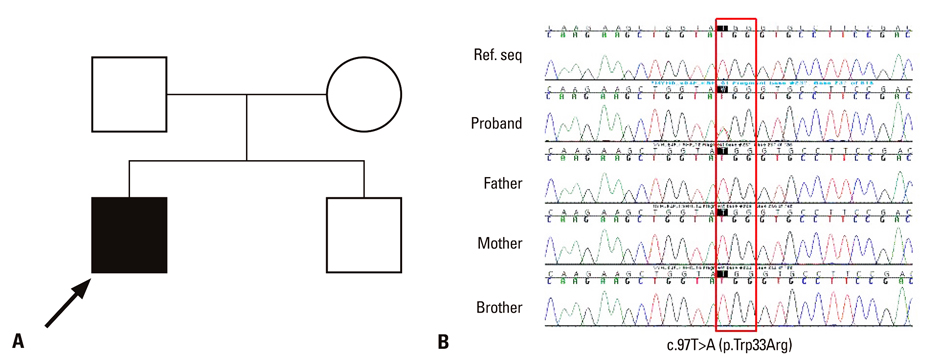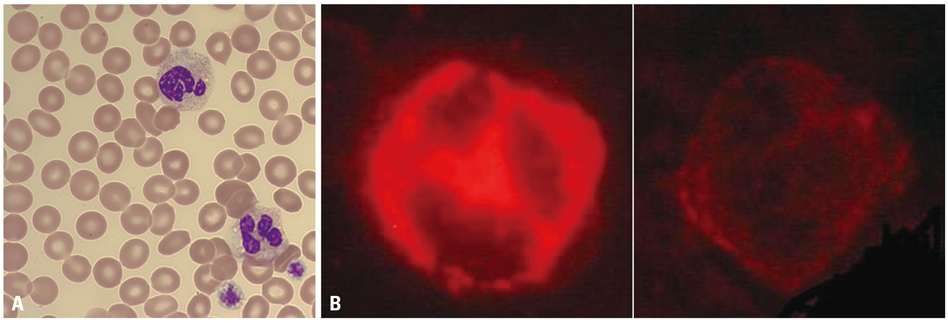Yonsei Med J.
2012 May;53(3):662-666. 10.3349/ymj.2012.53.3.662.
A Trp33Arg Mutation at Exon 1 of the MYH9 Gene in a Korean Patient with May-Hegglin Anomaly
- Affiliations
-
- 1Department of Internal Medicine, School of Medicine, CHA University, Seongnam, Korea. doh@cha.ac.kr
- 2Department of Laboratory Medicine, School of Medicine, CHA University, Seongnam, Korea.
- 3Department of Internal Medicine, Seoul National University College of Medicine, Seoul, Korea.
- 4Department of Laboratory Medicine & Genetics, Sungkyunkwan University School of Medicine, Seoul, Korea.
- 5Cardiac and Vascular Center, Samsung Medical Center, Sungkyunkwan University School of Medicine, Seoul, Korea.
- KMID: 1777006
- DOI: http://doi.org/10.3349/ymj.2012.53.3.662
Abstract
- In this report, we describe a Korean patient with May-Hegglin anomaly from a mutation of the MYH9 gene. The proband was a 21-year-old man with thrombocytopenia. He did not have a bleeding tendency. His neutrophil count was normal at 7490/mm3; however, the neutrophils contained abnormal basophilic inclusions in their cytoplasm. The platelet count was decreased at 15000/mm3 with giant platelets. Coagulation test results were not remarkable. Direct sequencing of MYH9 revealed that he was heterozygous for a mutation in exon 1, which was a 97T>A substitution mutation affecting codon 33, substituting tryptophan with arginine (Trp33Arg). Family study showed that both of his parents had normal phenotype and genotypes, indicating a de novo occurrence of the mutation in the proband.
Keyword
MeSH Terms
Figure
Cited by 1 articles
-
Frequently Delayed Diagnosis and Misdiagnosis in MYH9-related Disorders: Data from Genetically Confirmed Cases of Korean Patients
Chang-Hun Park, Young-Eun Kim, Ki-O Lee, Sun-Hee Kim, Kook-Hwan Oh, Inho Kim, Doyeun Oh, Hee-Jin Kim
Lab Med Online. 2019;9(4):224-231. doi: 10.3343/lmo.2019.9.4.224.
Reference
-
1. May R. Leukozyteneinschlusse. Dtsch Arch Klin Med. 1909. 96:1–6.2. Hegglin R. Gleichzeitige konstitutionelle Veranderungen an Neutrophilen und Thrombozyten. Helv Med Acta. 1945. 12:439–440.3. Kelley MJ, Jawien W, Ortel TL, Korczak JF. Mutation of MYH9, encoding non-muscle myosin heavy chain A, in May-Hegglin anomaly. Nat Genet. 2000. 26:106–108.
Article4. Seri M, Cusano R, Gangarossa S, Caridi G, Bordo D, Lo Nigro C, et al. Mutations in MYH9 result in the May-Hegglin anomaly, and Fechtner and Sebastian syndromes. The May-Heggllin/Fechtner Syndrome Consortium. Nat Genet. 2000. 26:103–105.
Article5. Saposnik B, Binard S, Elbaz S, Trichet C, Pouplard C, Roussel-Robert V, et al. MYH9-related disease (MYH9-RD), from one thing to the other: 11 novel mutations and 3 new exons affected. J Thromb Haemost. 2009. 7:Abstract AS-TH-043.6. Al-Marwani AO, Pearson D, Wagner B, Ong AC, Makris M, Daly ME. Molecular genetic basis of inherited thrombocytopenia. J Thromb Haemost. 2009. 7:Abstract PP-MO-075.7. Althaus K, Greinacher A. MYH9-related platelet disorders. Semin Thromb Hemost. 2009. 35:189–203.
Article8. Pecci A, Panza E, Pujol-Moix N, Klersy C, Di Bari F, Bozzi V, et al. Position of nonmuscle myosin heavy chain IIA (NMMHC-IIA) mutations predicts the natural history of MYH9-related disease. Hum Mutat. 2008. 29:409–417.
Article9. Pecci A, Canobbio I, Balduini A, Stefanini L, Cisterna B, Marseglia C, et al. Pathogenetic mechanisms of hematological abnormalities of patients with MYH9 mutations. Hum Mol Genet. 2005. 14:3169–3178.
Article10. Kunishima S, Matsushita T, Yoshihara T, Nakase Y, Yokoi K, Hamaguchi M, et al. First description of somatic mosaicism in MYH9 disorders. Br J Haematol. 2005. 128:360–365.
Article11. Lee AN, Nam CH, Kim BS, Song KS. A family case of May-Hegglin anomaly. Korean J Hematol. 1992. 27:195–199.12. Lee MA, Kim SM, Jin JY, Kim SY. A family case of May-Hegglin anomaly. Korean J Clin Pathol. 1992. 12:463–466.13. Im CB, Lee JK, Kim JW, Kwon KC, Koo SH, Park JW, et al. A family case of may-hegglin anomaly. Korean J Hematol. 1993. 28:157–163.14. Lee JH, Park SY, Kim YS, Dai J, Kim BC. The May-Hegglin anomaly in a family. J Korean Pediatr Soc. 1994. 37:1449–1452.15. Lim J, Park SJ, Kim Y, Lee JW, Han K, Kang CS, et al. A family case of May-Hegglin anomaly. Korean J Hematol. 1999. 34:492–495.16. Kunishima S, Matsushita T, Kojima T, Amemiya N, Choi YM, Hosaka N, et al. Identification of six novel MYH9 mutations and genotype-phenotype relationships in autosomal dominant macrothrombocytopenia with leukocyte inclusions. J Hum Genet. 2001. 46:722–729.
Article17. Song KS, Choi JR, Song JW, Ha SK. A nonsense C5797T (R1933X) mutation of MYH9 gene in a family with May-Hegglin anomaly. Korean J Hematol. 2001. 36:253–256.18. Back HJ, Kook H, Byun HS, Song ES, Kim SY, Lee JS, et al. MYH9-related disorder in a family: autosomal dominant epstein giant platelet syndrome. Korean J Pediatr Hematol Oncol. 2003. 10:99–104.19. Schleinitz N, Favier R, Mazodier K, Difeo A, Ebbo M, Veit V, et al. [The MYH9 syndrome: report of a new case with a new mutation of the MYH9 gene]. Rev Med Interne. 2006. 27:783–786.20. Kunishima S, Hamaguchi M, Saito H. Differential expression of wild-type and mutant NMMHC-IIA polypeptides in blood cells suggests cell-specific regulation mechanisms in MYH9 disorders. Blood. 2008. 111:3015–3023.
Article21. Kunishima S, Hirano K, Hamaguchi M, Saito H. Accumulation of MYH9 mRNA at leukocyte inclusion bodies in MYH9 disorders. Eur J Haematol. 2008. 81:325–326.22. Kunishima S, Matsushita T, Hamaguchi M, Saito H. Identification and characterization of the first large deletion of the MYH9 gene associated with MYH9 disorders. Eur J Haematol. 2008. 80:540–544.
Article23. Miyajima Y, Kunishima S. Identification of the first in cis mutations in MYH9 disorder. Eur J Haematol. 2009. 82:288–291.24. Miyazaki K, Kunishima S, Fujii W, Higashihara M. Identification of three in-frame deletion mutations in MYH9 disorders suggesting an important hot spot for small rearrangements in MYH9 exon 24. Eur J Haematol. 2009. 83:230–234.
Article
- Full Text Links
- Actions
-
Cited
- CITED
-
- Close
- Share
- Similar articles
-
- May-Hegglin Anomaly Diagnosed by Genetic Study in a Newborn Infant
- A Nonsense C5797T (R1933X) Mutation of MYH9 Gene in a Family with May-Hegglin Anomaly
- A Case of Myosin-heavy-chain-9 (MYH9) Gene Mutation Confirmed May-Hegglin Anomaly: 11-year Follow-up
- A Case of Thrombocytopenia with MYH9 Gene Mutation Found in Siblings
- Neonatal Thrombocytopenia due to MYH9 Missense Mutation: A Case Report



